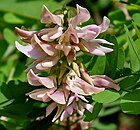Note: This is a project under development. The articles on this wiki are just being initiated and broadly incomplete. You can Help creating new pages.
Difference between revisions of "Pistacia chinensis - Chakrangi"
(→Uses) |
(→External Links) |
||
| Line 76: | Line 76: | ||
==External Links== | ==External Links== | ||
| − | + | ||
| − | |||
| − | |||
| − | |||
| − | |||
[[Category:Herbs]] | [[Category:Herbs]] | ||
Revision as of 14:06, 24 September 2018
Kakkar is glorious tree native to the lower Himalayan slopes, from Afghanistan to Kumaon, cultivated for its attractive leaves, which are bright red when young.
Contents
- 1 Uses
- 2 Parts Used
- 3 Chemical Composition
- 4 Common names
- 5 Properties
- 6 Habit
- 7 Identification
- 8 List of Ayurvedic medicine in which the herb is used
- 9 Where to get the saplings
- 10 Mode of Propagation
- 11 How to plant/cultivate
- 12 Commonly seen growing in areas
- 13 Photo Gallery
- 14 References
- 15 External Links
Uses
Coughs, Phthisis, Asthma, Dysentery.
Parts Used
Chemical Composition
Common names
| Language | Common name |
|---|---|
| Kannada | Chakrangi, kaakada shringi, karkaataka shringi |
| Hindi | kakra, kakra-singi, kareran, kakare, kakkar |
| Malayalam | NA |
| Tamil | kakkata-shinigi |
| Telugu | kakarashingi, kaakara shingi |
| Marathi | kaakad shingee, kaakada, kakra |
| Gujarathi | NA |
| Punjabi | NA |
| Kashmiri | NA |
| Sanskrit | chakra, chakrangi, chandraspada, ghosha, karkata |
| English | Kakkar |
Properties
Reference: Dravya - Substance, Rasa - Taste, Guna - Qualities, Veerya - Potency, Vipaka - Post-digesion effect, Karma - Pharmacological activity, Prabhava - Therepeutics.
Dravya
Rasa
Guna
Veerya
Vipaka
Karma
Prabhava
Habit
Identification
Leaf
| Kind | Shape | Feature |
|---|---|---|
| Paripinnate | Oblong | Leaf Arrangementis Alternate-spiral |
Flower
| Type | Size | Color and composition | Stamen | More information |
|---|---|---|---|---|
| Unisexual | 2-4cm long | pink | Flowering throughout the year and In terminal and/or axillary pseudoracemes |
Fruit
| Type | Size | Mass | Appearance | Seeds | More information |
|---|---|---|---|---|---|
| oblong pod | Thinly septate, pilose, wrinkled | seeds upto 5 | Fruiting throughout the year |
Other features
List of Ayurvedic medicine in which the herb is used
- Vishatinduka Taila as root juice extract
Where to get the saplings
Mode of Propagation
How to plant/cultivate
A plant of the warm temperate to subtropical zones, just entering into the tropics in northern Myanmar. It can tolerate frosts. It prefers growing in areas with a mean annual rainfall in the region of 1,270mm[3]
Commonly seen growing in areas
Dry slopes, Valleys along rivers.
Photo Gallery
References
External Links
- Ayurvedic Herbs known to be helpful to treat Coughs
- Ayurvedic Herbs known to be helpful to treat Phthisis
- Ayurvedic Herbs known to be helpful to treat Asthma
- Ayurvedic Herbs known to be helpful to treat Dysentery
- Herbs with Galls used in medicine
- Herbs with Fruits used in medicine
- Herbs with common name in Kannada
- Herbs with common name in Hindi
- Herbs with common name in Malayalam
- Herbs with common name in Tamil
- Herbs with common name in Telugu
- Herbs with common name in Marathi
- Herbs with common name in Sanskrit
- Herbs with common name in English
- Habit - Deciduous Tree
- Index of Plants which can be propagated by Propagation
- Index of Plants which can be propagated by Cuttings
- Herbs that are commonly seen in the region of Dry slopes
- Herbs that are commonly seen in the region of Valleys along rivers
- Herbs





